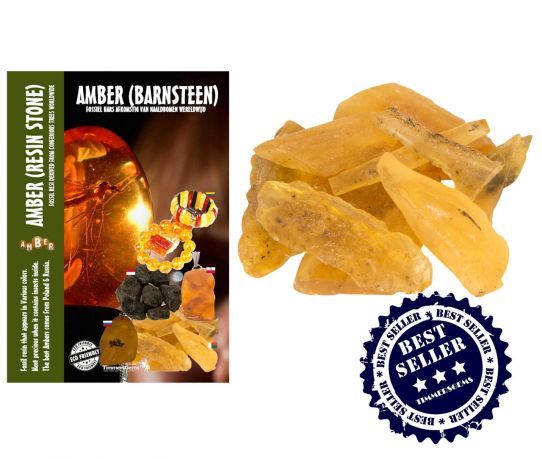We use cookies to make your experience better.
Amber "Copal" from Bekily,(Telear) Madagaskar
- Buy 1000 for €0.15 each and save 21%
Succinic (incorrectly also called amber) is a fossil resin which is derived from coniferous trees. These trees were often referred to by the scientific name Pinus succinifera, a living pine species. The resin millions of years ago dripped from the trees and then petrified. Amber dating from the Mesozoic to the Quaternary. Amber is usually warm yellow to dark red in color, but there are more green, blue or even black types. Transparent amber is generally found the most beautiful and the most precious. Mineralogical seen succinic has an amorphous structure. It is quite soft, the hardness is 2-2.5. The word amber - in German Bernstein - comes from the Lower Saxon word that means Bornen burn. Indeed, this gemstone is flammable. Hot amber in English amber. In Dutch with amber usually meant the color amber. Also, a substance from the intestines of the sperm whale is called amber. This substance smells strong and is used in perfumes. The fact that many insects are found in amber also not escape the Romans. They stated this (correctly) by assuming that amber was liquid when it covered the insects. Therefore they called the stone Succinum or gum-stone. And the name still occurs in succinic acid (succinic acid), the scientific name for the pine species Pinus succinifera and also succinite, a name given by James Dwight Dana was given to a certain type of amber originating from the Baltic region. A general group of land snails are amber snails. They are so named because of the amber yellow color of the cochlea. The scientific name of a kind of amber snails reads Succinea putris. Amber is electrically charged by rubbing it along an animal fur. For this reason, the term electricity derived from the Greek word for amber, electron (Latin: electrum). In Greek mythology, the god Helios let one day his son Phaeton drive the solar car. But Phaeton could not rein in the horses, so the sun heaven and earth scorched. So were the people in Ethiopia their dark color. To save the earth Zeus throws his thunderbolt to Phaeton causing this death falls to the ground. The sisters of Phaeton, the Heliades, mourn him. Their tears trickle down and solidify into amber. The Greek mythological character Elektra is identified with amber. The Greek word for amber is "electron" (ηλεκτρον) from which our word "electricity" coming as a amber was up to the Greeks from the amber islands which one situated at the mouth of the legendary Amber River in the far north, the Eridanos.
The most beautiful minerals, fossils and gemstones from Madagascar
Madagascar, officially the Republic of Madagascar and previously known as the Malagasy Republic, is an island country in the Indian Ocean, off the southeastern coast of Africa. The nation comprises the island of Madagascar (the fourth-largest island in the world), as well as numerous smaller peripheral islands. Amongst it's famous spot for diving and swimming it is famous for it's high quality gemstones that are extracted from the soil and rocks. We at Timmersgems can say with proud that we are the second largest importer for Madagaskian gemstones in Europe just after a French company. Anualy we have at least 3 large containers filled with the most beautiful gemstones, minerals and bufallo horns. If you take a look in our webshop and showroom you will come accross great Labradorite, Amethyst, Citrine, Rose Quartz and many many other great ones. We are doing business with 17 small family businesses on the island and this way we can guarantee you the best prices in the market for best gemstones and minerals. Also we support these families since we started our business 35 years ago we are almost in love with the island,it's people and the products. Every year it is a great thing to visit the island and find the best stones for you. Also we support all the small family businesses and their children to give them a good education, also we support in local infra structure an water transportation. Madagascar's natural resources include a variety of unprocessed agricultural and mineral resources. Agriculture, including raffia, fishing and forestry, is a mainstay of the economy. Madagascar is among the world's principal suppliers of vanilla, cloves and ylang-ylang. Other key agricultural resources include coffee, lychees and shrimp. Key mineral resources include various types of precious and semi-precious stones, and Madagascar currently provides half of the world's supply of sapphires, which were discovered near Ilakaka in the late 1990s. The island also holds one of the world's largest reserves of ilmenite titanium ore), as well as important reserves of chromite, coal, iron, cobalt, copper and nickel. Several major projects are underway in the mining, oil and gas sectors that are anticipated to give a significant boost to the Malagasy economy. These include such projects as ilmenite and zircon mining from heavy mineral sands near Tôlanaro by Rio Tinto Madagascar is a very poor country witgh a lot of flora and fauna, On Madagaskar you can find 400 plants and animals you will never find anywhere in the world. Also the minarals blue celstite, Labradorite and polychrome & Oceanjasper are found only on Madagascar.












